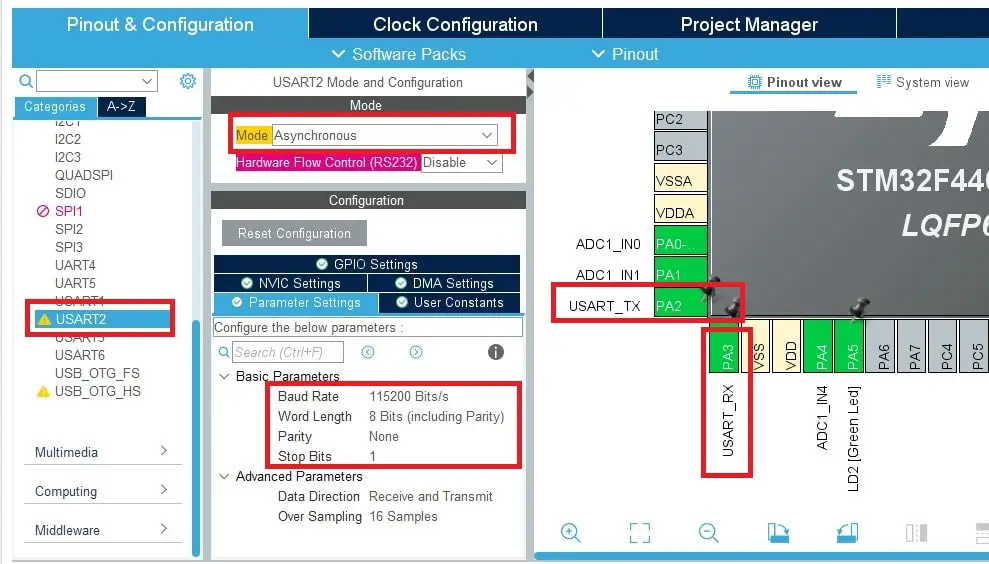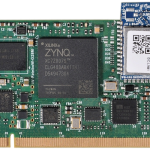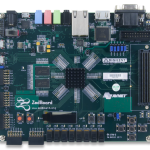STM32 ADC configuration is a crucial aspect of working with STM32 microcontrollers, allowing developers to harness the power of Analog to Digital Converters for various practical applications. In this guide, we will navigate through the STM32 ADC tutorial, offering clear steps to configure the ADC in STM32 devices effectively. From enabling the clock to calibrating the ADC, mastering the basics will greatly enhance your ability to read analog signals accurately and integrate them into your projects. Whether you’re measuring sensor outputs or internal metrics like temperature and voltage, understanding the intricacies of the STM32F0 ADC setup will set a solid foundation for your embedded systems development. Join us as we delve deeper into using ADC in STM32 microcontrollers, helping you to unlock their full potential in your electronic designs.
Diving into the realm of STM32 microcontrollers, the configuration of analog-to-digital converters (ADCs) emerges as a fundamental skill for embedded system developers. Mastery of configuring these converters is essential for accurate signal processing and sensor integration in various applications. This article aims to simplify the process of ADC setup in the STM32 series, including techniques to calibrate these devices and select appropriate sampling rates. With a solid understanding of how to manipulate the ADC settings, including those prevalent in STM32F0 models, you will pave the way for improved data acquisition and analysis in your projects. Embracing the nuances of ADC usage opens a world of possibilities for sensor-driven applications, making it a vital area of focus for anyone interested in microcontroller programming.
Understanding ADCs in STM32 Microcontrollers
An Analogue to Digital Converter (ADC) plays a critical role in embedded systems by transforming continuous analog signals into digital values that can be processed by microcontrollers. In the realm of STM32 microcontrollers, the ADCs are integral components that facilitate various applications, such as sensor readings and signal processing. With resolutions ranging from 12 to 16 bits, these converters allow for precise measurements, which are fundamental in controlling applications like motor drives, temperature measurements, and more.
The prevalence of ADCs in STM32 MCUs adds significant value to developers, enabling them to interface effectively with the real world. By harnessing the functionalities of internal temperature sensors and external sensors, developers can create applications that react dynamically to changes in their environment. This capability is pivotal in modern applications that require real-time data collection and processing, showcasing the need to understand how to configure and utilize ADCs efficiently.
Key Steps in STM32 ADC Configuration
Configuring the ADC in STM32 involves several crucial steps that ensure optimal performance and accuracy. The first task is to enable the ADC’s clock within the Reset and Clock Control (RCC) to ensure that the ADC module receives power and is ready for operations. Following this, calibration is a significant step; running the calibration routine applies factory-provided calibration factors that enhance measurement precision. Proper calibration is particularly important in applications where measurement accuracy is critical, such as in automotive and industrial environments.
Once the clock is enabled and the ADC calibrated, the next phase involves selecting an appropriate clock source. STM32 provides options for synchronous and asynchronous clock sources. Selecting the right clock source impacts the speed and accuracy of conversions; therefore, careful consideration is necessary to select a clock that best suits the application requirements. The STM32F0’s asynchronous clock sourced from HSI14 is often the choice for high-speed applications.
Calibration of STM32 ADCs
Calibration is an essential part of configuring the STM32 ADC as it considerably enhances the reliability of sampled data. When performing ADC calibration, the ADC peripheral must be activated, requiring the clock to be enabled while the ADC itself is not active. This is achieved by writing to specific bits in the control registers. Calibration routines should be run with care, ensuring that the regulator is activated if required, particularly on certain models like the STM32F3, to maintain accurate readings.
Adopting proper calibration practices not only improves the accuracy of the ADC readings but also ensures consistency across different devices and applications. This factor is particularly vital when dealing with varying environmental conditions and different sensor types. Engaging the calibration process correctly allows developers to trust the data they collect, making it essential for critical applications that rely on precision.
Choosing the Right Clock Source for ADC
The selection of an appropriate clock source is pivotal in configuring STM32 ADCs, affecting both performance and operational stability. The ADC clock can be provided from synchronous sources, such as AHB or APB, or from asynchronous sources that are not tied to the main system clock. For optimal performance, selecting an asynchronous clock source can minimize potential issues related to clock-domain resynchronization, especially in complex applications.
For instance, in the STM32F0 series, setting the clock source to the high-speed HSI14 ensures that the ADC operates efficiently without compromising performance. Once the clock source is set, developers need to wait for it to stabilize before proceeding with further ADC configurations. Utilizing a stable clock source not only enhances conversion times but also increases the accuracy of the samples taken, fostering cleaner and more reliable data.
Configuring ADC Channels in STM32
In STM32 microcontrollers, configuring the ADC channels is a vital step that allows multiple input sources to be sampled. The ADCs can interface with various external and internal channels, easily allowing connections to sensors, voltage references, and internal temperature readings. For STM32F0 devices, channel selection requires the activation of specific control bits in the ADC_CHSELR register to include the desired inputs in the sampling sequence.
Moreover, it’s imperative to set the appropriate sample time for each channel, as some inputs may need longer times for accurate readings, particularly in the case of internal temperature sensors. For better accuracy when sampling, the STM32F0 ADCs require setting the sample time to the highest available to avoid discrepancies in readings. Configuring channels correctly ensures that developers can gather data effectively from the full spectrum of available analog inputs.
Initiating ADC Sampling Sequences
Once the ADC channels are configured, the next step is to initiate the sampling sequence, which involves triggering the ADC to start capturing data from the selected channels. This requires verifying that the ADC is ready for operation by ensuring the ADRDY flag in the ADC_ISR register is cleared. Activating the ADC by setting the ADEN bit in the control register signals the microcontroller to commence the sampling process.
The sampling sequence will typically involve capturing readings from each active channel sequentially. Upon completion of each sampling cycle, programmers need to monitor the EOC (End Of Conversion) flag to confirm when a new value is ready for processing. This organized flow of initiating ADC sampling facilitates structured data collection, allowing further processing or output of the converted values to be conducted in real-time.
Handling and Processing Sampled Values from ADC
Once sampling is completed, the sampled values can be processed and utilized in the application logic. Depending on the bit resolution of the ADC, values will range from 0 up to the maximum bit representation. For instance, a 12-bit ADC in STM32 will yield results between 0 and 4095, allowing developers to perform meaningful calculations based on these values. For example, interpreting the sampled value of a potentiometer can be done easily with basic calculations that convert the ADC reading back into the corresponding voltage.
Moreover, specific applications such as temperature sensing require further computations to transform the raw ADC readings into meaningful real-world values. By applying calibration equations, such as those found in device datasheets, developers can achieve accurate conversions from the ADC’s output to temperature readings. This offers flexibility in the functionality of ADCs in STM32, enhancing the robustness of applications across various industries.
Future Expansions and Advanced Features of STM32 ADCs
While the foundational understanding of ADCs in STM32 microcontrollers has been addressed, advanced features such as continuous sampling, interrupt handling, and multi-mode operations can expand their utility significantly. Future articles will delve deeper into these features, exploring how developers can implement more complex sampling strategies that are efficient and cater to a broader range of applications.
As microcontroller applications grow increasingly sophisticated, leveraging the full capabilities of STM32 ADCs—such as using multiple ADCs for simultaneous sampling—can greatly enhance data acquisition systems. This versatility allows for innovative applications that improve system responsiveness, data integrity, and overall user experience. By understanding and exploring these features, developers can stay ahead in the ever-evolving landscape of embedded systems.
Frequently Asked Questions
What is the basic concept of STM32 ADC configuration?
STM32 ADC configuration involves setting up the Analog to Digital Converter in STM32 microcontrollers to measure analog voltages and convert them into digital values. This includes enabling the ADC clock, calibrating the ADC for enhanced accuracy, and selecting the appropriate clock source for optimal performance.
How do you calibrate ADC in STM32 microcontrollers?
To calibrate the ADC in STM32 microcontrollers, first enable the ADC clock, then turn off the ADC. Set the ADCAL bit in the ADC control register and monitor its status to check for completion. For STM32F3 devices, also activate the voltage regulator before calibration.
How to configure the channels for STM32 ADC setup?
When configuring channels for STM32 ADC, select the input channels in the ADC channel selection register and set the desired sample time. For example, configure channels 1 (GPIO) and 16 (Vsense) with the appropriate settings in the ADC registers for F0 series devices.
What are the steps to set up STM32 ADC?
The steps to set up STM32 ADC include enabling the clock in the RCC enable register, calibrating the ADC, selecting a clock source, and configuring the input channels you wish to sample. Finally, initiate the ADC sequence for sampling and processing the data.
What is the resolution of the ADC in STM32 microcontrollers?
The ADC in STM32 microcontrollers typically has a resolution ranging from 12 to 16 bits, with 12 bits being the most common. This allows for precise measurements of analog signals.
How do you select the clock source for STM32 ADC?
To select the clock source for STM32 ADC, choose between synchronous (AHB or APB derived) or asynchronous sources. For instance, setting the CKMODE in the ADC_CFGR2 register along with enabling the high-speed ADC clock provides an efficient asynchronous option.
Why is ADC calibration important in STM32 configuration?
ADC calibration is crucial in STM32 configuration as it applies factory-calibrated values that improve the accuracy of the ADC readings. This ensures that the converted digital values closely represent the actual analog input.
Can you explain multi-mode configuration for STM32 ADC?
Multi-mode configuration in STM32 ADCs allows multiple ADCs to work simultaneously, enabling more complex data acquisition and processing tasks. This is ideal for applications requiring multiple analog measurements at high speeds.
What types of channels can be configured in STM32 ADC?
STM32 ADCs can be configured with several types of channels, including external GPIO-connected channels and internal channels like temperature sensors, voltage references, and battery voltage measurements.
How do you handle sampled values from STM32 ADC?
To handle sampled values from STM32 ADC, read the ADC data register once the End Of Conversion (EOC) bit is set. The sampled value will range from 0 to the maximum bit value, and if needed, scale the value to determine the actual analog voltage.
| Key Component | Description |
|---|---|
| ADC Overview | Converts analog voltage to digital value in STM32 MCUs. Uses ADCs for various functionalities including temperature and voltage measurements. |
| Configuration Steps | 1. Enable clock in RCC; 2. Calibrate ADC; 3. Select clock source depending on application needs. |
| Calibration Process | Ensure the clock is enabled, set ADCAL bit, monitor for completion. Calibration enhances accuracy. |
| Clock Source Selection | Select between synchronous or asynchronous clock sources, ensuring stabilization before use. |
| Channel Configuration | Configure analog input channels. For F0 use CHSELR, for F3, use SQR registers for sequence. |
| Sampling Process | Set ADEN to activate ADC, start sequence with ADSTART, and read result from ADC_DR after EOC is set. |
| Handling Outputs | Scale ADC readings to actual voltage or temperature using calibration values. |
Summary
STM32 ADC configuration is crucial for effectively utilizing the Analog to Digital Converters present in STM32 microcontrollers. Understanding the process involves enabling the necessary clocks, proper calibration, channel configuration, and correctly handling sampled values. Following these steps allows developers to harness the ADC functionality for tasks ranging from simple potentiometer readings to advanced sensor integrations, ultimately enhancing their embedded system applications.






